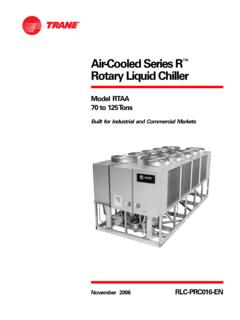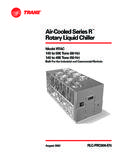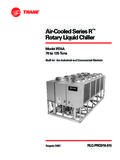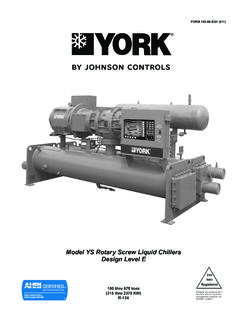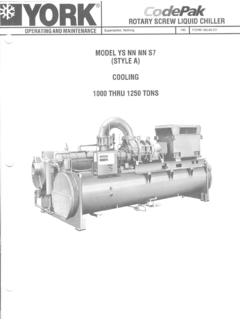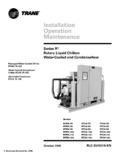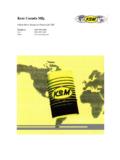Transcription of Large Chilled Water System Design Seminar
1 Large Chilled Water System Design SeminarPresented by:Larry Konopacz, Manager of Training & EducationBell & Gossett Little Red SchoolhouseThis presentation is being brought to you by:ASHRAE India Chapter and Xylem, , September 21, 2013 Large Chilled Water System Design SeminarThe Production Loop Chillers Cooling towers Free-Cooling &Waterside Economizer Thermal Storage Water Source Heat PumpsChilled Water SourcesI Ton Ice =2000 LB;1LB Ice =144 Btu;1 Ton ice =288,000 BtuWhat s a Ton?12,000 Btu/h = 500 x gpm x t F = 1 tongpm/ton = 12,000/(500 x t F)= 24/ t FRule of 24 What Types of Chillers are Available? Centrifugal Rotary screw Reciprocating AbsorptionEvaporatorCondenserCompressorR efrigeration CycleCooling TowerCondenserCondenserWater Pump CompressorMotorExpansion DeviceChilledWaterPumpHigh Pressure ZoneLow Pressure ZoneLoadHot WaterLiquid FlowReturnWaterVapor FlowCool WaterSupplyWaterEvaporatorWhere is What Used?
2 Large Chilled Water plants - centrifugal Mid-range size - rotary screw Smaller Chilled Water applications -reciprocating Inexpensive source of steam or other energy source - absorption Combinations of the aboveCHILLERC hiller 2 Chiller 1 SupplyReturnCommon PipeChiller Piping - Evaporator SideSupplyReturnCommonPipeTripleDutyChil ler 3 Chiller 2 Chiller 1 TripleDutyTypical Piping MethodSupplyReturnCommonPipeTripleDutyCh iller 2 TripleDutyChiller 1 Adding Pump RedundancyPiped forStandbyPumpsSupplyReturnCommonPipeTri pleDutyChiller 3 Chiller 2 Chiller 1 TripleDutyActuated Control ValveHeadered Primary PumpsChiller Piping - Condenser SideCondenserCondenserCondenserPumpsCool ing Towers Triple DutySRSSRSSRST ripleDuty Standby PumpCondenserCondenserCondenserMulti-cel l Cooling TowerSRSM ulti-celled Cooling TowerCooling TowersTriple DutyCondenserCondenserCondenserEqualizat ionLineSRST ower EqualizationCooling Tower Piping Practices Fill all sections of pipe to purge air.
3 Size piping at a minimum of 2 fps to move free air bubbles to tower. All piping installed below System purge Purge LevelSRSC ondenser Water Piping Above GradeOverhead Piping Concerns Piping manifolds can result in low velocities. Low velocity will allow air to be released. Air trapped in piping increases head required. Piping installed above purge level compounds problem. Unpurged areas are potential sources of problems when pumps are turned Suction Piping Concerns Condenser Water pump difficult to purge. At start-up a manual air vent may be required. During operation air will again accumulate. Automatic air vent may not work. If above the basin fill level, the result is Piping Above Basin LevelSystem Purge LevelBasin Fill LevelSystem Purge LevelSRSM ulti-tower System , Properly PipedTower Piping Observations At part load reduced velocities in headers may allow air to be released. Idle pumps will accumulate air that should be released prior to starting the pump.
4 Tower basins should be elevated to ensure positive pressure under all flow conditions. Pump casings should be fitted with automatic air Head Pressure ControlWith centrifugal chillers a minimum supplywater temperature is needed to: Maintain optimum efficiency Maintain a minimum pressure differential between condenser and evaporator Prevent pressure imbalance Hermetic Compressor Guidelines Condenser Water temperature > 75 F. Establish 75 F within 15 minutes. N/O condenser Water throttling valve. Three-way bypass valve can be used. Constant condenser Water flow. Water temperature control through fan modulation, or other Compressor Guidelines Condenser Water temperature > 55 F. Three-way bypass valve can be used. Constant condenser Water flow. Water temperature control through fan modulation, or other InWater outAir inAir outCooling TowersWater outAir inAir inWater inAir OutInduced Draft, Counter-flow TowerAir OutAir inAir inWater outWater inForced Draft, Cross-flow TowerTemperatureWater FlowHot Water F Cold Water F Wet bulb F L lb/min of Water L lb/min of waterLoadRange( R F) Approach( F) Heat Load = L x RDynamic Relationship of Load, Approach, and RangeTower Size RelationshipsVariables: Heat Load (Varies Directly) Range (Varies Inversely) Approach (Varies Inversely) Wet-bulb Temperature (Varies Inversely)Varying any of these variables will affect the size of the of Free-Cooling(Waterside Economizer) Water outAir inAir inWater inAir OutEarth ContactEvaporativeEarth Contact Characteristics Usually indirect.
5 Cooling medium and load separated by heat exchanger. Stable temperatures. Water temperature limitations. Water treatment and pumping costs. Environmental ExchangersHow do they work? Thin plates are stamped with a unique chevron pattern and assembled in a frame Four holes punched in the plate corners form a continuous tunnel which acts as a distribution manifold for the inlet and outlet of each fluidHow do they work? Each plate has a gasket that confines the fluid to the port or to the heat transfer area of the plate Units are built to order with a standard 150 psi ASME Code stamped Design or to custom designsLOADCONDEVAPT riple DutySediment RemovalSeparatorTriple DutyTOWERHEATEXCHGPXE arth Contact - Summer CycleLOADCONDEVAPT riple DutySediment RemovalSeparatorTriple DutyTOWERHEATEXCHGPXE arth Contact - Winter CycleEvaporative Characteristics Heat rejection device (tower) exists. As temperature declines, opportunity arises.
6 Higher sensible vs. latent loads Leaving Water temperature approaches 42 F. Freeze protection may be Protection Sump heaters. Close temperature control. Accurate Water level control. Prevention of moist air recirculation. External piping freeze Cooling - DirectLOADCONDEVAPT riple DutyTriple DutySediment RemovalSeparatorTOWERS ingle Tower, Summer CycleLOADCONDEVAPT riple DutyTriple DutySediment RemovalSeparatorTOWER* Alternate location of SRS, depending onsystem conditionsNOT RECOMMENDEDS ingle Tower, Winter CycleEvaporative Cooling - DirectEvaporative Cooling - IndirectLOADCONDEVAPT riple DutySediment RemovalSeparatorTriple DutyTOWERHEATEXCHGPXS ingle Tower/GPX, Summer CycleEvaporative Cooling - IndirectLOADCONDEVAPT riple DutySediment RemovalSeparatorTriple DutyTOWERHEATEXCHGPXS ingle Tower/GPX, Winter CycleCOND. WATERCH. FEXCHANGERLENGTH57=42=45=52=7 F TEMPERATURECROSS3 F COOLINGAPPROACHT1t2t1T2 Temperature Cross and ApproachTemperatures are in F Flow is in USGPMHeat exchanger selection based on max pressure drop of 7 psi10 Approach = 3F10 Approach = 4F10 Approach = 5 FCOND.
7 WATERCH. LWT FLOWEWT LWT FLOWDEG MODELINDEX 42 52 1000 57 45 834 1390 GPX807 42 52 1000 58 46 834 1135 GPX807 42 52 1000 59 47 834 975 GPX807 Transfer Area vs ApproachProduction Source - Thermal Storage Application Criteria Economics Storage Media Storage Technologies System ConfigurationsApplication Criteria High maximum load. Significant premium for peak demand. Incentives. Limited space available. Limited electrical capacity. Back-up or redundancy Media Chilled Water Ice Harvesting External/Internal Ice MeltTVentLoadPressure sustainingand check valveStorageWarmCoolVariable volumedistributionpumpConstant volumeprimary pumpChillerStratified Chilled Water System30 40 50 60 70-5-10-15 Bottom -20 Top 0 Depth of tank, ftTemperature, F ThermoclineTemperature StratificationVentPressure sustainingand check valveStorageWarmCoolConstant volumeprimary pumpChillerDistributionpumpPrimary pumpLoadTransferPumpDirectioncontrolvalv esUse of Pressure Sustaining ValvesLoadTVentPressure sustainingand check valveStorageWarmCoolVariable volumeprimarypumpConstant volumeprimary pumpChillerTHeat ExchangerVariable volumesecondarypumpIncorporating Heat ExchangersSection1 Section2 Section3 Section4 Ice harvesterchillerLoadChilled Water pumpIce waterrecirculationpumpIce Harvesting SystemCharging ModeDischarging ModeExternal Melt Ice StorageIceWaterIceCold glycolWarm glycolCharging ModeDischarging ModeEncapsulated Ice StorageCharge and Discharge ModesTonsTime of DayCooling load (met by storage)ChargingStorageChargingStorageCh iller meets load directlyChiller onChiller offFull Storage StrategyTonsTime of DayCooling load(met by storage)ChargingStorageChargingStorageCo oling load(met by chiller)
8 Chiller runs continuouslyPartial Storage - Load LevelingTonsTime of Day(met by storage)ChargingStorageChargingStorage(m et by chiller)Cooling loadReduced on-peak demandPartial Storage - Demand LimitingProduction Source - Water Source Heatpumps Growing market segment System temperature range 40 - 90 F Energy added below 40 F (heat) Heat removed above 90 F (cooling tower)Air Coil(Evaporator)CoolAirCompressorReversi ngValveCapillaryAir Conditioner CoolingAir Coil(Condenser)WarmAirReversingValveCapi llaryAir Conditioner HeatingWater Coil(Evaporator) Water Coil(Condenser) System WaterSupplyReturnCompressorRefrigerantLo opHeat Pump Cycles - Water SourceDesign Considerations Use slow closing two-way valves for each zone Good System balance required Use staged c/s or v/s pumps Use with cooling towers and GPX Use with closed circuit cooling towersWater SourceHeat PumpWater SourceHeat PumpWater SourceHeat PumpWater SourceHeat PumpWater SourceHeat PumpWater SourceHeat PumpWater SourceHeat PumpWater SourceHeat PumpWater SourceHeat PumpBufferTank( Optional )Compression TankGasketedPlate HeatExchangerCoolingTowerHeat Pump- Water Source SchematicClosed Circuit CoolerHeat RejecterWater SourceHeat PumpWater SourceHeat PumpWater SourceHeat PumpWater SourceHeat PumpWater SourceHeat PumpWater SourceHeat PumpWater SourceHeat PumpWater SourceHeat PumpWater SourceHeat PumpBufferTank( Optional )Compression TankHeat Pump- Water Source SchematicComments?
9 Questions?Observations? Large Chilled Water System Design SeminarVariable Volume DistributionVariable flow through coil Constant flow through System Three Way ValveVariable flow through coil Variable flow through System Two Way ValveThree-Way Valve Systems Low return temperatures Balance problems Increased flow at part load Extra chillers to provide flow at low t Chillers operate at high kW/tonCHILLERCHILLERTwo-Way Valve System with Chiller BypassAWe want:a. variable volume, to save pumping costs at part load,b. constant flow through the chiller to protect Solutiona. constant flow primary System for the chillersb. variable flow secondary System for the loadA ProblemCHILLERCHILLERCHILLERR eturnPrimary-SecondaryCommon PipeSupplyPrimary LoopProductionSecondary LoopDistributionPrimary-Secondary TermsFundamental IdeaSecondaryPump Tee A PrimaryPumpTee B Low pressure drop in the common pipe Primary-Secondary PumpingThe idea is based on: Conservation of Mass Conservation of Energy50 GPM100 GPM50 GPMLaw of the Tee: Diversion40 GPM60 GPM100 GPMLaw of the Tee.
10 MixingNo Secondary Flow100 GPM @ 45 FSecondaryPump OffAB100 GPM @ 45 F100 GPM @ 45 FPrimaryPumpPrimary = Secondary100 GPM @ 45 F0 GPMPump OnAB100 GPM @ 45 F100 GPM @ 55 F100 GPM @ 55 FPrimary > SecondaryPump OnABMixing at Tee B100 GPM @ 45 F50 GPM @ 45 F100 GPM @ 50 F50 GPM @ 55 F50 GPM @ 45 FPump OnABMixing at Tee A100 GPM @ 45 F100 GPM @ 55 F100 GPM @55F200 GPM @ 50 F200 GPM @ 55 FPrimary < SecondaryTwo-way ValveControl Valve in SecondaryPrimary-Secondary PumpingCHILLERCHILLERCHILLERR eturnPrimary-SecondaryCommonSupplyPrimary LoopProductionSecondary LoopDistributionCommon Pipe Design Criteria Use the flow of the largest chiller Chiller staging at half of this flow is common Head loss in common <1 1/2 ft Distribution pipe size is often used where reductions would be inconvenient Three pipe diameters between tees Excessive length increases total head loss Low velocities in System pipingReturnSupplyPumpControllerSecondaryConstant SpeedPumpsCommonChiller 3 Chiller 2 Chiller 1 Design of the Common Pipe10 Pipe ConfigurationsABCDHeadF1F2F3H1H2H3 FlowControl ValvesClosingControl ValvesOpeningSecondary System CurveFrom LoadsCommonTo LoadsProductionSecondary Pumps1500 gpm eachDistributionChiller 2, offChiller 1, on1500 gpmeach45 FTypical SystemCommon--NoFlowSecondaryPumps15001500150015000 CHWS Temp45oFCHWR Temp55oFECW Temp55oF1500 Chiller 2, offChiller 1, onProduction = DistributionCommon-- 500 SecondaryPumps15002000150020000 CHWS Temp55oFECW Temp55oFMixing (1500 @ 45) + (500 @ 55)Chiller 2, offChiller 1, on2000 Distribution > Production>1500 GPMR eturnCommonSupply>1500 GPM0 GPM>1500 GPM@ >1500 GPM@ 55oFBe Careful!

